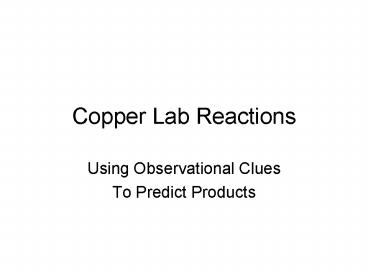Copper Lab Reactions PowerPoint PPT Presentation
1 / 12
Title: Copper Lab Reactions
1
Copper Lab Reactions
- Using Observational Clues
- To Predict Products
2
Step 1a
- Copper turns black when heated strongly in air.
- Cu(s) O2(g) ? CuO(s)
- black
- Redox (oxidation)
3
Step 1b
- Adding dilute H2SO4 solution to the black product
dissolves the black product off the surface of
the Cu, leaving behind the reddish Cu we started
with. - The solution containing the dissolved product is
clear blue. - CuO(s) H2SO4(aq) ? CuSO4(aq) H2O(l)
- blue
- Double Displacement (acid-base)
4
Step 1c
- When NaOH solution is added to the CuSO4 solution
from 1b, a blue gel precipitate forms. - CuSO4(aq)NaOH(aq)?Cu(OH)2(s)Na2SO4(aq)
- blue gel ppt
- Double displacement (precipitation)
5
Step 1d
- When H2SO4 solution is added to the blue gel, the
gel dissolves and we get back a blue solution. - Cu(OH)2(s)H2SO4(aq)?CuSO4(aq)H2O(l)
blue soln - Double Displacement (acid-base)
6
Step 1e
- When the blue gel is heated, we get a solid black
product. - Cu(OH)2(s) ?CuO(s) H2O(l)
- blue gel black solid
- Redox -- decomposition
7
Step 2a
- When blue CuSO45H2O crystals are heated, they
turn white. Clear white liquid droplets form at
the top of the tube. - CuSO45H2O(s) ? CuSO4(s) 5H2O(l) blue
crystals white powder - (not a reaction type that weve studied. Not
redox/decomposition, since electrons arent
transferred between atoms)
8
Step 2b
- When water is added to the white powder from 1b,
we get back the blue crystals we started with.
Addition of even more water gives us our familiar
blue solution. - CuSO4(s) 5H2O(l) ? CuSO45H2O(s)
- CuSO45H2O(s) H2O(l) ? CuSO4(aq)
- (again, not reactions were interested in
identifying)
9
Step 3
- When an iron nail is added to the CuSO4(aq) we
made in 2b, the nail turns reddish in color and
the blue color in the solution fades. - CuSO4(aq) Fe(s) ? Cu(s) FeSO4(aq)
- blue soln reddish
- Redox single displacement
10
Step 4
- When sulfuric acid solution is added to green
copper(II) powder, we get a gas that turns
limewater cloudy and we get back our familiar
blue solution. - CuCO3(s)H2SO4(aq)?CO2(g)CuSO4(aq)H2O(l)green
pwdr blue
soln - Double-Displacement - acid-base !!!
11
Step 4b
- When the green copper carbonate powder is heated,
a gas is given off that turns limewater cloudy,
and a black solid is left in the test tube. - CuCO3(s) ? CuO(s) CO2(g)green pwdr black
solid - Redox - decomposition
12
Step 4c
- When charcoal is added to the black solid from 4b
and the mixture is heated, a gas is given off
that turns limewater cloudy, and reddish solid
flecks form in the bottom of the tube. - CuO(s) C(s) ? Cu(s) CO2(g)black
reddish - Redox Single Displacement

